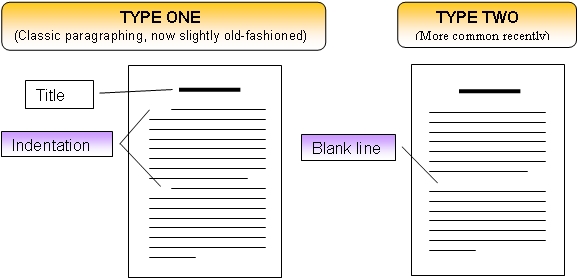Paragraphing
Paragraphing is part of the visual presentation of your essay or assignment along with punctuation, spelling, double spacing, page numbering etc. However, unlike all the above which are mechanical and fairly easily checked for problems (since simple rules can be applied to them), paragraphs can require a considerable amount of thought and effort to get right. However a well-paragraphed essay signals a careful, organised writer (a good way to pick up marks!) and so it is worth making sure that you have done everything you can to improve them.
Why is paragraphing important?
What is the point of paragraphing? Why not just write our ideas in one long stream? Why not write each sentence starting on a new line? Look at a text which is formatted in three different ways to find out.
Task
Check out a list of basic principles to paragraphing.
Basic principles to paragraphing
There are some basic principles to paragraphing. Some of these apply to the visual impact on the reader, others to the content. Both aspects are important.
Visual impact
-
A new paragraph is signalled by starting a new line AND either indenting slightly OR leaving a blank line. Choose one style and stick to it throughout your essay. See the diagrams below for examples of each type.
- One sentence is not a paragraph in academic writing. It is possible to find one sentence paragraphs in magazine articles and novels but good academic style does not have one sentence paragraphs.
- An average paragraph should be between 4 and 7 sentences long and should take up about 2/5 of the page (i.e. you should aim to have about 2 and a half paragraphs per page). This is an AVERAGE and so it will not matter if you occasionally have a slightly longer or shorter paragraph. Introductions and conclusions particularly tend to be shorter than the other paragraphs in an essay.
-
A consistent length to your paragraphs shows the effort you have made to make your essay easier for your reader to grasp. It is therefore another good way to pick up marks.

Content
-
A paragraph contains a 'packet of information'. Each paragraph in your essay should therefore have a different packet so that you are not repeating yourself.
-
The 'packet of information' is more than one sentence can contain, but is less than your total essay. It should have a single point that is developed with some or all of the following: examples, quotations, references, definitions, explanations or (more rarely in academic writing) anecdotes.
-
Ideally your paragraphs will build up, one upon the other, each packet of information helping to develop your argument one stage further.
-
Although it may be clear to you how two paragraphs are linked, it is important to make it clear to your reader what the connection is.
-
A guiding principle for both sentences and paragraphs is that shorter is better than longer. When a paragraph starts to take up more than half a page, stop and see how you could say what you want to say in two or may be three paragraphs instead.
-
Typical features of the average paragraph are: a topic sentence (usually the first one) which sums up what the paragraph will be about, often linking it to what has gone before; development sentences which explain or illustrate the point; a concluding sentence which hints at how the next paragraph will carry on.